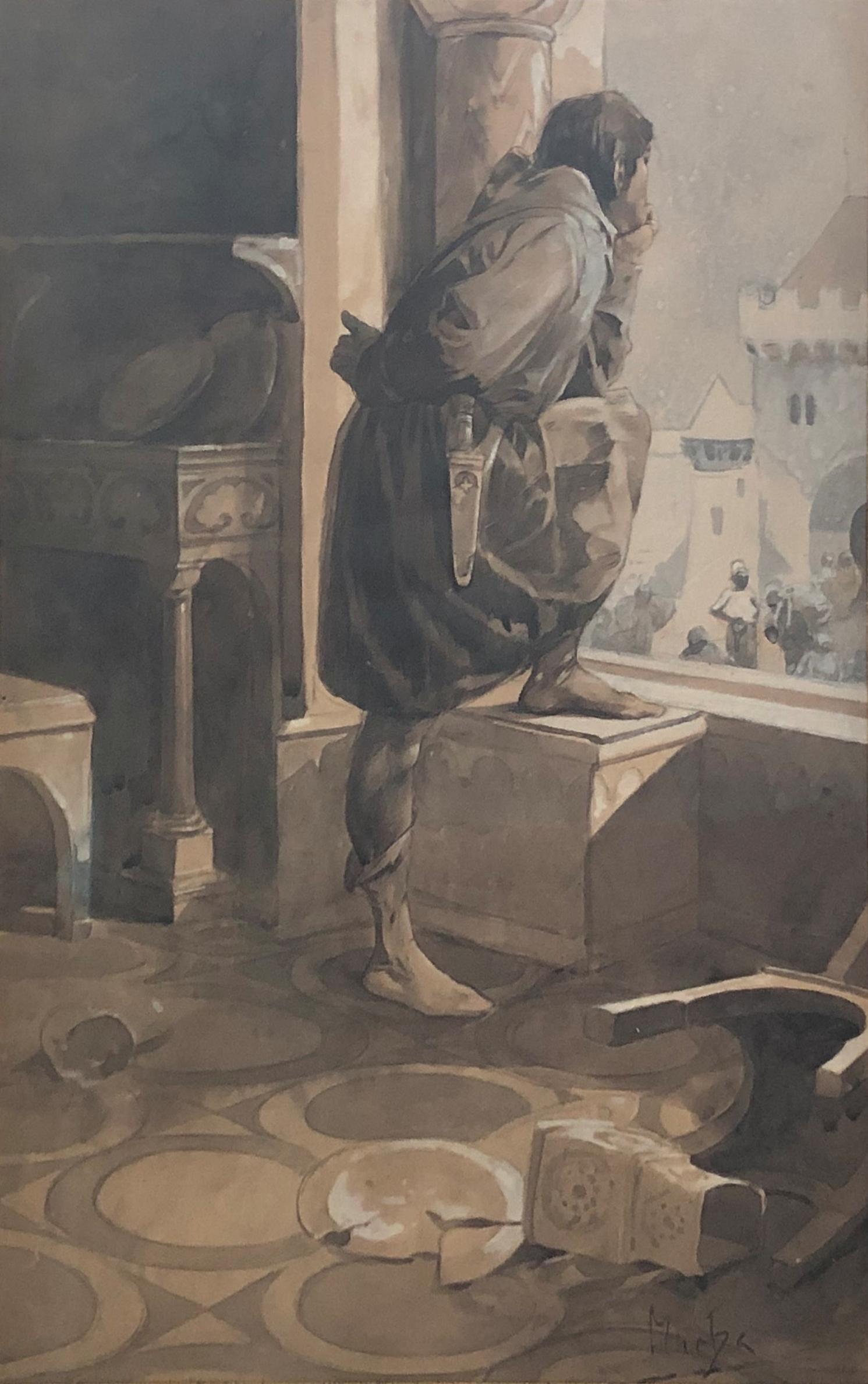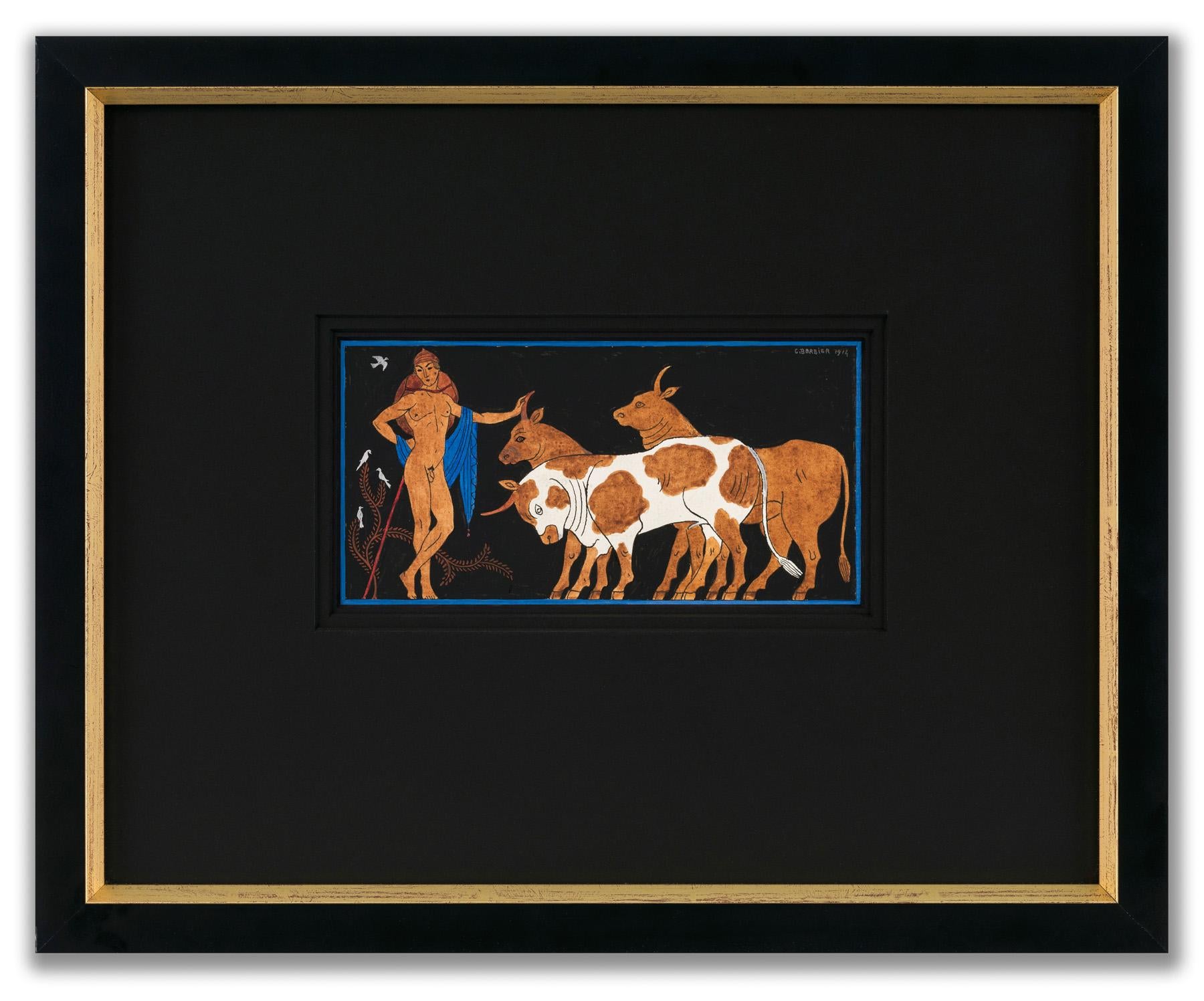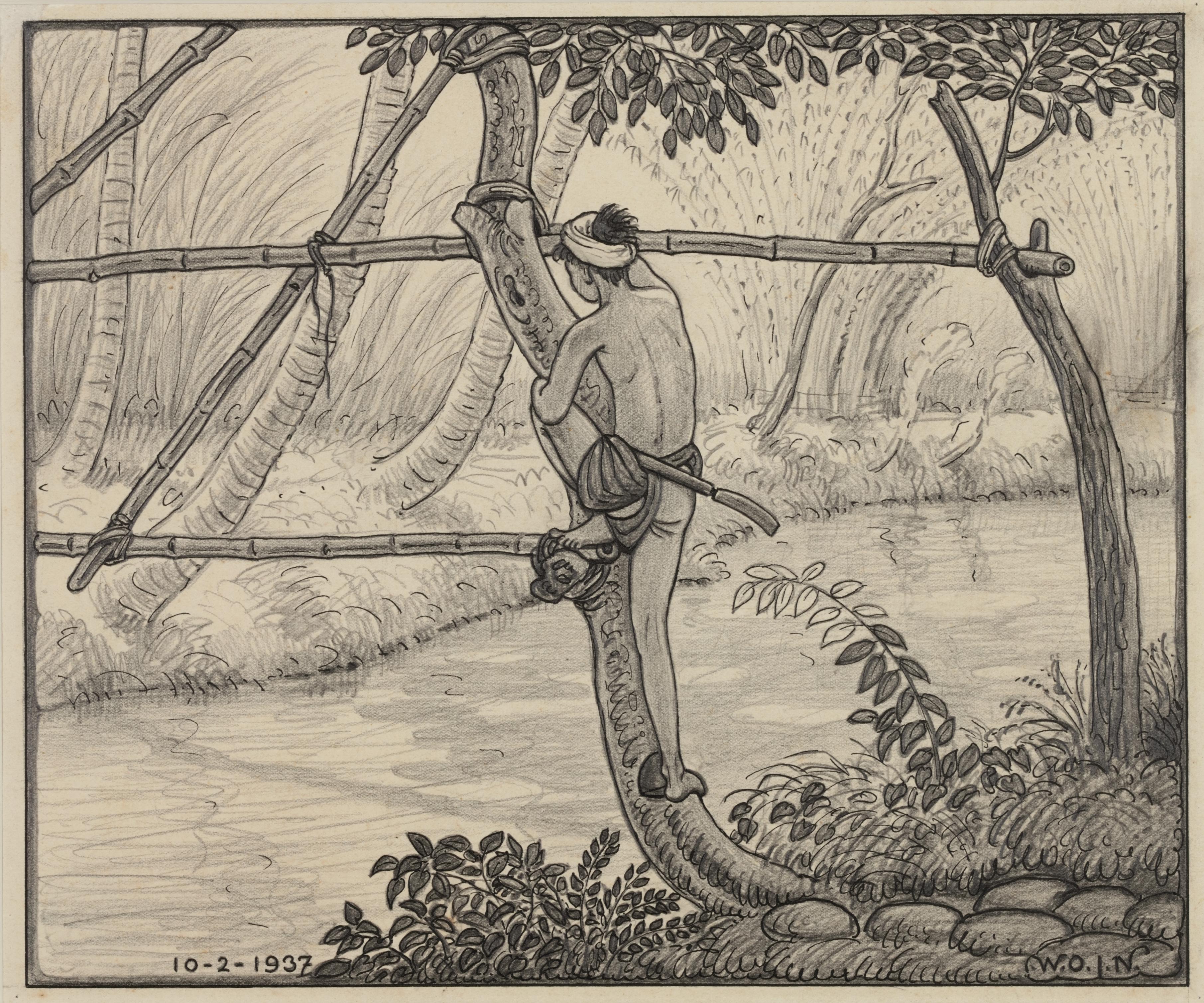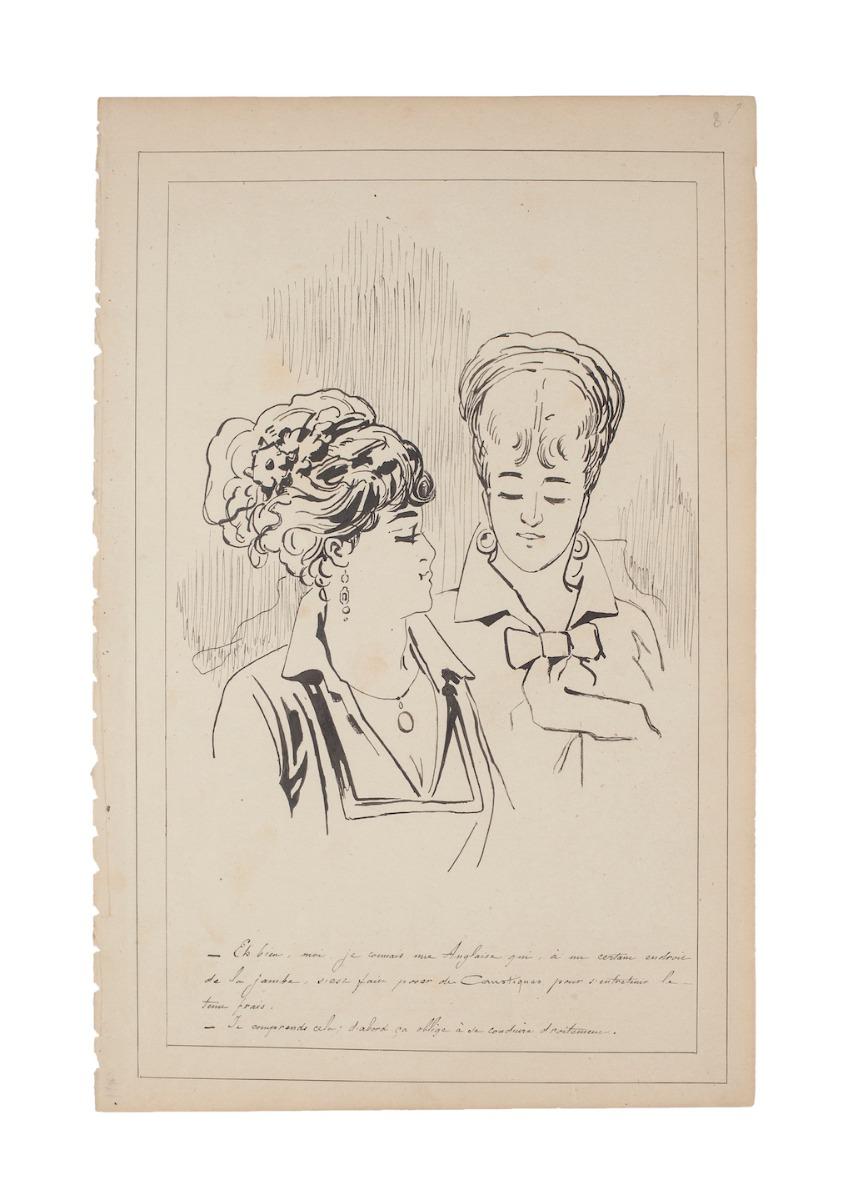Felician MyrbachFelician Myrbach (1853-1940) Le Cadeau de Sahagun, original dawingcirca 1895
circa 1895
About the Item
- Creator:Felician Myrbach (1853 - 1940)
- Creation Year:circa 1895
- Dimensions:Height: 11.74 in (29.8 cm)Width: 7.37 in (18.7 cm)
- Medium:
- Movement & Style:
- Period:
- Condition:
- Gallery Location:Paris, FR
- Reference Number:
Felician Myrbach
Felician Myrbach was born on February 19th, 1853, in Zalishchyky. He was an Austrian painter, graphic designer and illustrator. He was a founding member of the Vienna Secession and the director of the University of Applied Arts Vienna and was instrumental in the creation of the Wiener Werkstätte. Myrbach's father was Franz Myrbach, the Administrator of Bukovina in 1865–70. His older brother Franz Xaver was an economist and professor at the University of Innsbruck. Myrbach attended the Theresian Military Academy in 1868–71, graduating as a Lieutenant, then at the Academy of Fine Arts, Vienna under August Eisenmenger. In 1875, he joined the 19th Feldjäger Battalion, and in 1877 became an Oberleutnant in the Military Geographic Institute, then, after campaigning in Bosnia in 1878, he taught drawing at the Infantry Cadet School in Vienna. He continued his artistic studies under C R Huber. In 1881, Myrbach went on military leave and moved to Paris, retiring totally from the military in 1884 as a Hauptmann, 2nd Class. He stayed in Paris until 1897, working as an illustrator, including illustrating the works of Alphonse Daudet, Victor Hugo and Jules Verne. Myrbach was a founding member of the Vienna Secession in 1897. In the same year, he became a professor of the Applied Arts School at the Museum of Art and Industry; Arthur von Scala, another reformer Modernist, was made head of the Museum. In 1889, Myrbach became the director of the school. He brought an enthusiastic Modernist attitude and encouraged integration between art, design and production. He added Koloman Moser and Josef Hoffmann to the staff, amongst other Secession artists. This had lead to the foundation of the Wiener Werkstätte in 1903. Myrbach leaned more towards an aesthetic approach than von Scala, but both worked together to bring about their combined vision of successful, popular Austrian applied art. Myrbach was a voice for reform towards Modernist ideals in the School, which was started in 1899 with the support of Alfred Roller, and completed by 1901. The reform of the school has been described as his "lasting merit". Ludwig Hevesi called Myrbach "probably the best (illustrator) in Vienna", partially for his work (with Moser) in the Secession magazine Ver Sacrum. Myrbach visited America on a state-funded study trip in 1904, part of which was to represent the Applied Arts School at the 1904 World's Fair in St Louis; from California, he submitted his resignation to the school due to ill health. He moved abroad in 1905, first returning to Paris and providing illustrations for Hachette, and then from 1914 living in Spain, mainly in Barcelona but also spent time in Bilbao. He returned to Austria in 1936. Myrbach created many scenes of military life, as well as bucolic pictures of farmers, horses and forests; as well, his work showed touches of Orientalism. Until 1898, he employed algraphy in his work; he painted in oil, watercolor and tempera. Myrbach passed away on January 14th, 1940.
- ShippingRetrieving quote...Ships From: Paris, France
- Return PolicyA return for this item may be initiated within 14 days of delivery.
- Felician Myrbach (1853-1940) The Musketeers, original drawingBy Felician MyrbachLocated in Paris, FRFelician Myrbach (1853-1940) The Musketeers bears the monogram "M" on the lower left Ink and pencil on paper 26,7 x 23,7 cm in good condition, In a mod...Category
1890s Art Nouveau Figurative Drawings and Watercolors
MaterialsInk
- Felician Myrbach (1853-1940) Pour Guitare solo, original drawingBy Felician MyrbachLocated in Paris, FRFelician Myrbach (1853-1940) Pour Guitare solo, For Solo Guitar bears the monogram "M" in the middle left, titled in lower left Ink on paper 29,8 x 18,8 cm in good condition, traces...Category
1890s Art Nouveau Figurative Drawings and Watercolors
MaterialsInk
- Felician Myrbach (1853-1940) Poèmes magyarsBy Felician MyrbachLocated in Paris, FRFelician Myrbach (1853-1940) Poèmes magyars, Magyar poems bears the monogram "M" on the lower left, titled in the upper right Ink on paper 29,8 x 19,8 cm in good condition, the sheet is slightly yellowed In a modern frame : 33 x 23 cm This is an illustration project by Felician Myrbach for François Coppée's work, "Poèmes magyars". He leaves the space to be occupied by the text blank on the sheet and arranges his composition accordingly. It is interesting to see the artist imagine his drawing with this constraint. Felician Myrbach (also Felicien de Myrbach, Felician von Myrbach, from 1919 Freiherr von Rheinfeld) was born on 9 February 1853 in Zalishchyky, he died 14 January 1940 in Klagenfurt He was an Austrian painter, graphic designer and illustrator. He was a founding member of the Vienna Secession and the director of the Applied Arts School in Vienna (now the University of Applied Arts Vienna), and was instrumental in the creation of the Wiener Werkstätte. Myrbach's father was Franz Myrbach (1818–1882), the Administrator of Bukovina in 1865–70. His older brother Franz Xaver (1850–1919) was an economist and professor at the University of Innsbruck. He attended the Theresian Military Academy in 1868–71, graduating as a Leutnant, then at the Academy of Fine Arts, Vienna under August Eisenmenger. In 1875, he joined the 19th Feldjäger Battalion, and in 1877 became an Oberleutnant in the Military Geographic Institute, then, after campaigning in Bosnia in 1878, he taught drawing at the Infantry Cadet School in Vienna. He continued his artistic studies under C R Huber. In 1881, he went on military leave and moved to Paris, retiring totally from the military in 1884 as a Hauptmann, 2nd Class. He stayed in Paris until 1897, working as an illustrator, including illustrating the works of Alphonse Daudet, Victor Hugo and Jules Verne. Myrbach was a founding member of the Vienna Secession in 1897. In the same year, he became the a professor of the Applied Arts School at the Museum of Art and Industry; Arthur von Scala, another reformer Modernist, was made head of the Museum. In 1889, Myrbach became the director of the school. He brought an enthusiastic Modernist attitude and encouraged an integration between art, design and production. He added Koloman Moser and Josef Hoffmann to the staff, amongst other Secession artists. This would lead to the foundation of the Wiener Werkstätte in 1903. Myrbach leant more towards an aesthetic approach than von Scala, but both worked together to bring about their combined vision of successful, popular Austrian applied art. Myrbach was a voice for reform towards Modernist ideals in the School, which was started 1899 with the support of Alfred Roller, and completed by 1901.The reform of the school has been described as his "lasting merit". Ludwig Hevesi called Myrbach "probably the best [illustrator] in Vienna", partially for his work (with Moser) in the Secession magazine Ver Sacrum. Myrbach visited America on a state-funded study trip in 1904, part of which was to represent the Applied Arts School at the 1904 World...Category
Early 1900s Art Nouveau Figurative Drawings and Watercolors
MaterialsInk
- Felician Myrbach (1853-1940) L'Araignée du Prophète, original drawingBy Felician MyrbachLocated in Paris, FRFelician Myrbach (1853-1940) L'Araignée du Prophète, the spider of the Prophet bears the monogram "Mb" on the middle left, titled in the middle Ink on paper 31,8 x 21.9 cm in quite ...Category
1890s Art Nouveau Figurative Drawings and Watercolors
MaterialsInk
- Jean-Gabriel Domergue (1889-1962) Paris, Les Bouquinistes, original drawingBy Jean-Gabriel DomergueLocated in Paris, FRJean-Gabriel Domergue (1889-1962) Paris, Les Bouquinistes sur les quais, (The booksellers on the banks) Signed and titled lower right Pencil on paper 17 x 27 cm In good condition, ...Category
1920s Art Nouveau Portrait Drawings and Watercolors
MaterialsCarbon Pencil
- Lucien Victor Guirand de Scevola (1871-1950), Les Marionnettes 1910, drawingBy Lucien-Victor Guirand de ScévolaLocated in Paris, FRLucien Victor Guirand de Scevola (1871-1950) Portrait of Marie-Thérèse Piérat in Les Marionnettes, 1910 Pencil on paper, signed, dated and annotated lower ...Category
1910s Art Nouveau Portrait Drawings and Watercolors
MaterialsCarbon Pencil
- "Medieval Thoughts, Prague, " Alphonse Mucha, Czech Art Nouveau IllustrationBy Alphonse MuchaLocated in New York, NYAlphonse Mucha (Czech, 1860 - 1939) Medieval Thoughts, circa 1890 Wash, ink, and watercolor on paper 11 x 9 inches Signed lower right Provenance: Phillips New York, 19th and 20th ce...Category
1890s Art Nouveau Figurative Drawings and Watercolors
MaterialsWatercolor, Ink, Paper
- Lykas, The Songs of BilitisBy George BarbierLocated in London, GBWatercolour and Chinese ink on paper, signed and dated (upper right), 10cm x 17cm (30cm x 38cm framed). George Barbier was one of the great French illustrators of the early 20th century. Born in Nantes, France on 16 October 1882, Barbier was 29 years old when he mounted his first exhibition in 1911 and was subsequently swept to the forefront of his profession with commissions to design theatre and ballet costumes...Category
1910s Art Nouveau Nude Drawings and Watercolors
MaterialsPencil, Ink, Watercolor
- Wobbly bridge, Tabanan, Bali, 1937Located in Amsterdam, NLWobbly bridge, Tabanan, Bali, 1937 Signed with initials bottom right and dated, bottom left Pencil and ink on paper, 22 x 26.3 cm In ebonized frame with white mount Willem Otto Wi...Category
1930s Art Nouveau Landscape Drawings and Watercolors
MaterialsIndia Ink, Paper, Pencil
- Beach of Kusambe, Bali 1937Located in Amsterdam, NLFour outrigger proa’s on the beach of Kusambe, Bali, 1937 Signed with initials, dated and described with location bottom left Pencil and ink on paper, 29.7 x 35 cm In ebonized frame with white mount WILLEM OTTO WIJNAND NIEUWENKAMP (1874-1950) Nieuwenkamp was born on July 27th 1874 in Amsterdam. His father owned sailing ships sailing to Indonesia and hearing the stories of the returning captains evoked in the young Nieuwenkamp an obsession for distant lands and adventure. After a failed attempt by his father to have his son make a career in his business, Nieuwenkamp attended the Academy for Decorative Art in Amsterdam. However, he left within one year to go his own way. He was an autodidact and a great experimenter with new techniques, particularly in the art of etching. Nieuwenkamp was a very focused man with the discipline of a scientist tempered by the sensitivity of an artist, a lust for adventure, a natural appreciation for ethnic arts and an enormous ambition to tread new paths. In 1898 he visited Indonesia for the first time and on his second visit in 1903-1904 he went on to Bali and became the first foreign artist to love Bali and the Balinese with a passion. Having secured agreements with several museums in the Netherlands to obtain Balinese art and objects for their collections, Nieuwenkamp immediately started to purchase and order a wide range of ethnographic art and objects from local artists and craftsmen. Through his drawings and books, he gave an excellent impression of Balinese art and culture at that time. Since 1854 Northern Bali was under Dutch...Category
1930s Art Nouveau Landscape Drawings and Watercolors
MaterialsIndia Ink, Paper, Pencil
- Statue of Vishnu Garuda, Bali, 1904Located in Amsterdam, NLStatue of Vishnu Garuda, Bali, 1904 Signed with initials Pencil and ink on paper, 21.4 x 21.3 cm Literature: Bruce W. Carpenter, W.O.J. Nieuwenkamp. First European Artist in Bali,...Category
Early 1900s Art Nouveau Landscape Drawings and Watercolors
MaterialsPencil, Paper, India Ink
- Figures - Ink on Paper after G.H. de Beaumont - Early 20th CenturyLocated in Roma, ITFigures is an original modern drawing in pen on paper realized by an Anonymous artist of the early XX century after Gustave Henri de Beaumont (1851-1922). ...Category
Early 20th Century Art Nouveau Figurative Drawings and Watercolors
MaterialsInk






